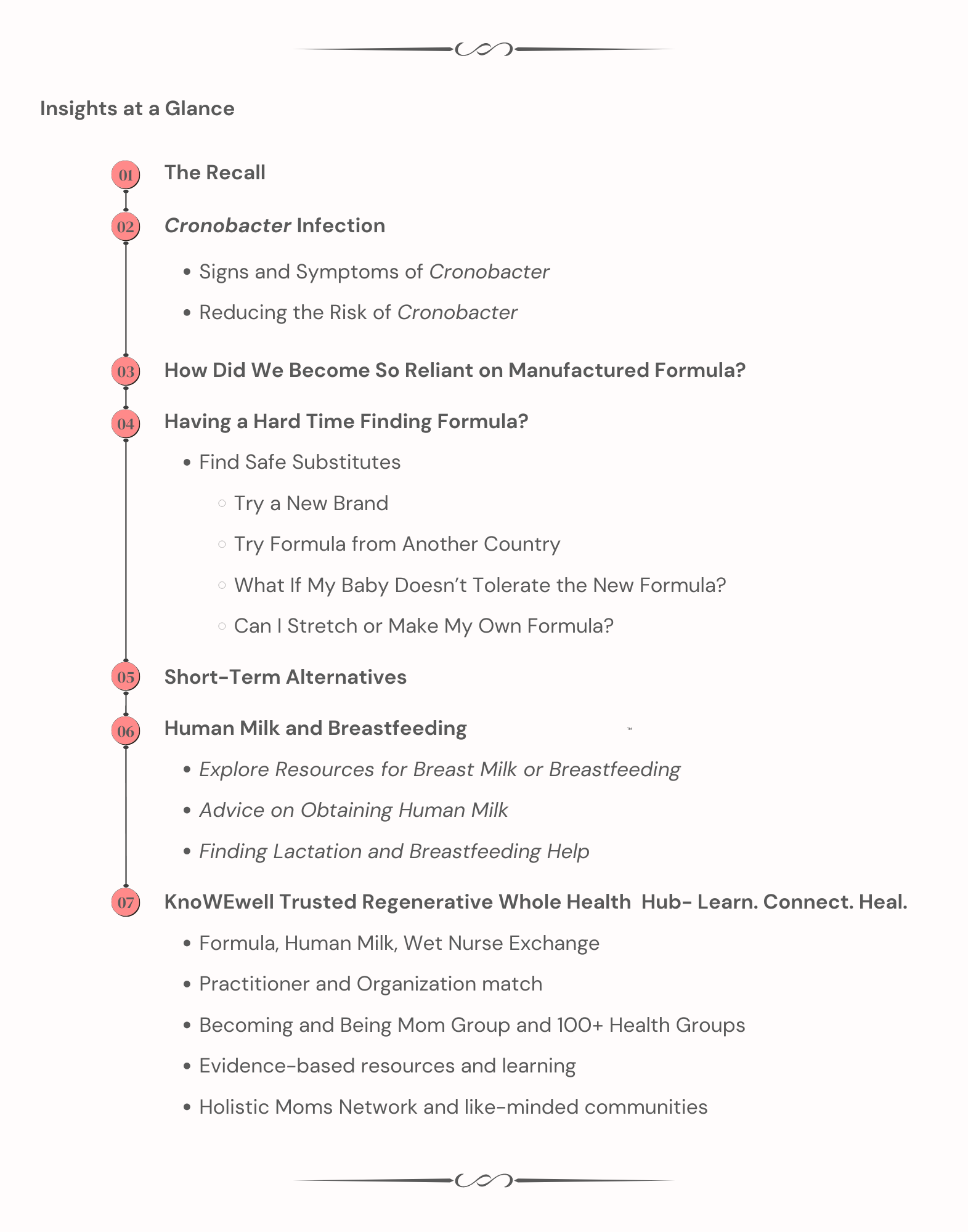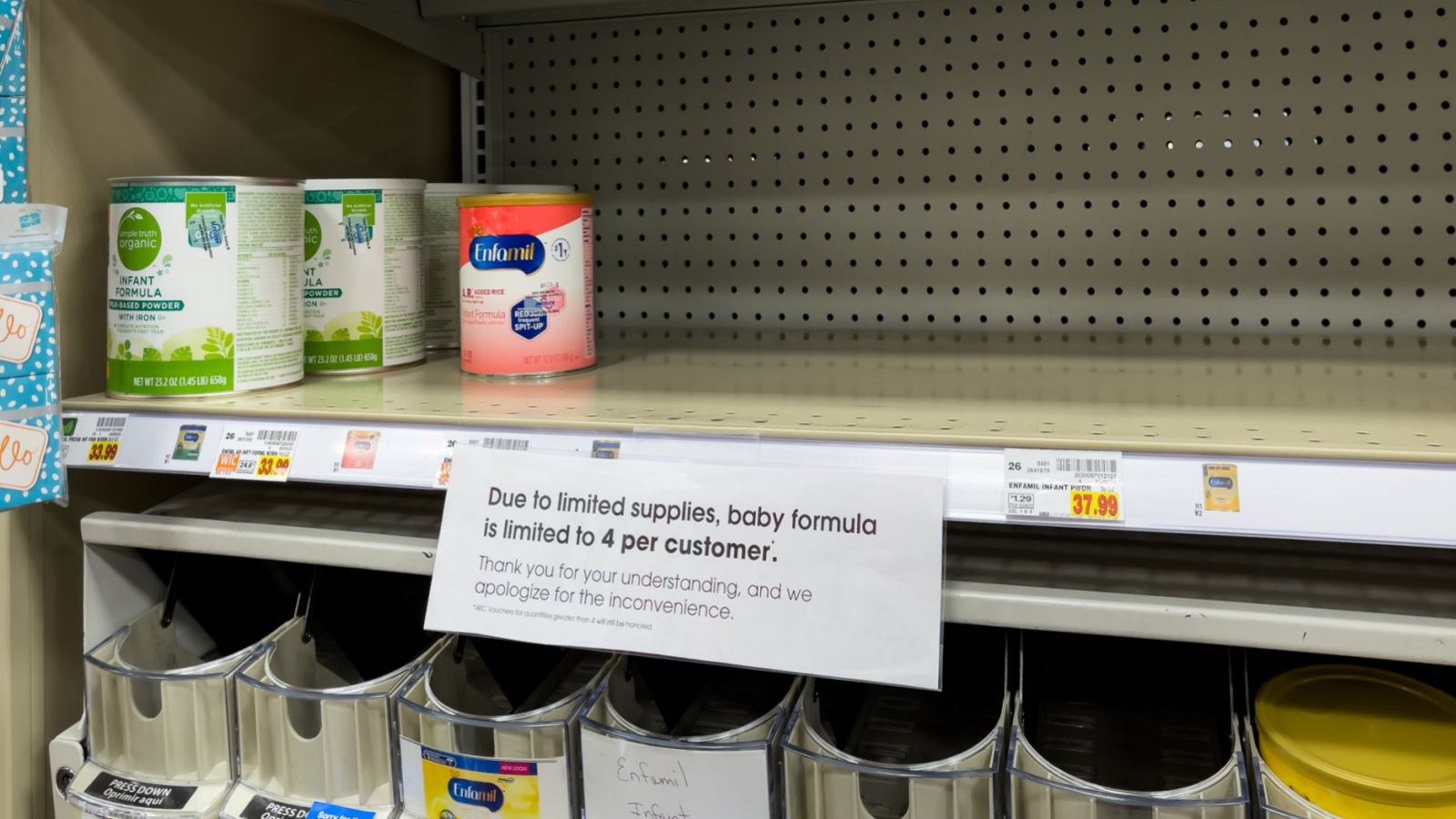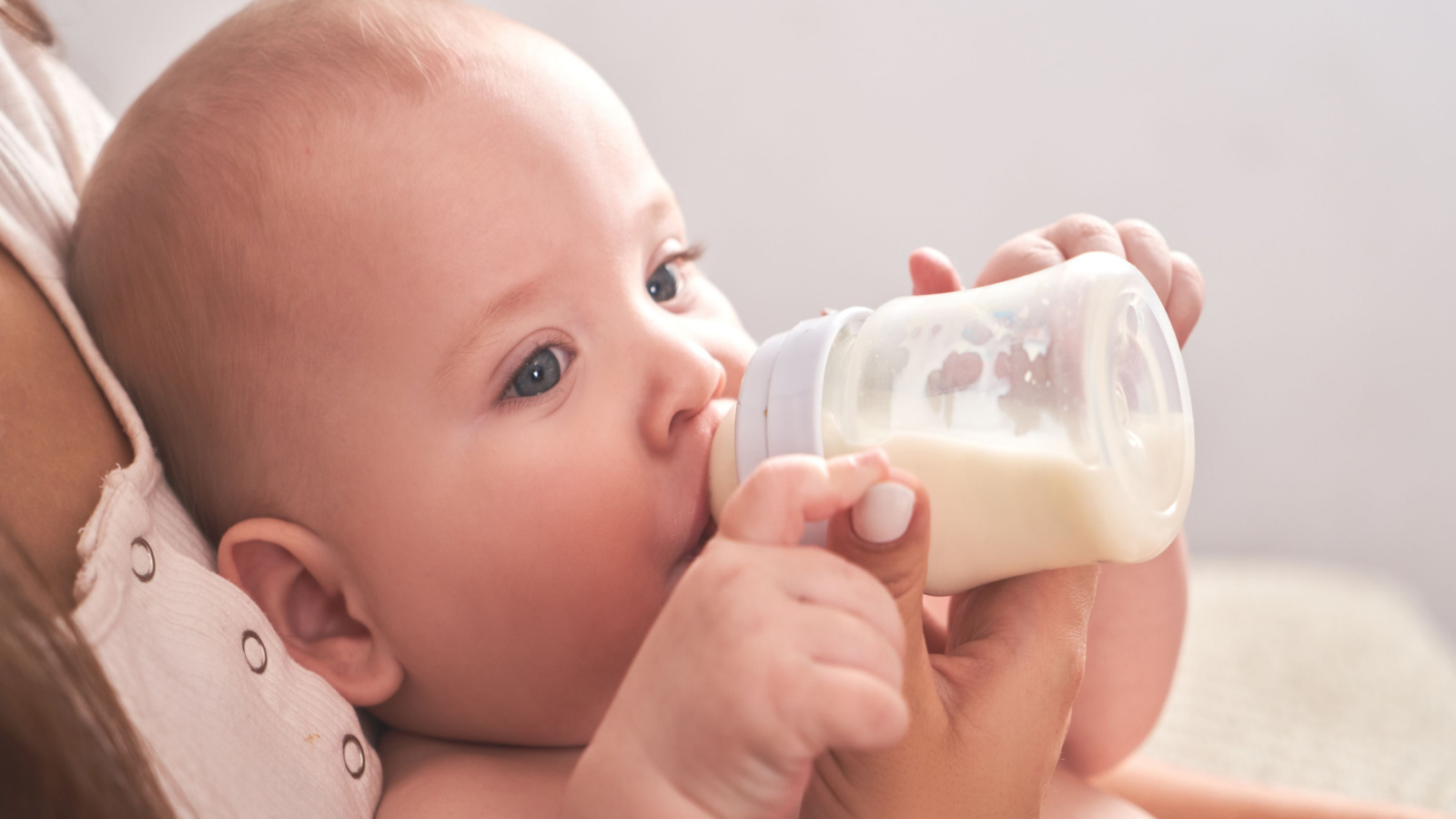

Industry News

Industry News
KnoWEwell Expands Hub for Formula, Human Milk, Wet Nurse Exchange
As a result of the pandemic, we have all experienced shortages or delays of one type of another in obtaining goods. But if you are a parent of an infant child, starting in February you likely began experiencing frightening shortages of essential baby formula because of a recall by one the industry leaders. And four months later the situation has gotten worse, not better.
KnoWEwell is here with updated information and resources to help worried parents, including a new exchange for formula, human milk, and wet nurse services. KnoWEwell founder and CEO, Kimberly Whittle, stated, “We are committed to using our community platform to help people in need. We have expanded our community directory filters for volunteers and families in need of infant formulas with a comprehensive list of over 192 formula brands, as well as human milk sources. KnoWEwell also offers parents information and support for making informed healthy lifestyle choices for themselves and their babies. By activating a free membership, families also can leverage our Hub to connect with volunteers and coordinate logistics.”

The Recall
In February 2022, Abbott Nutrition voluntarily recalled Similac® PM 60/40, Similac® Alimentum®, and EleCare® powder baby formulas after complaints that five infants were infected with Cronobacter sakazakii or Salmonella Newport who had consumed powder infant formula manufactured in its Sturgis, Michigan plant. Two infants with Cronobacter sakazakii later died. Preliminary findings from a US Food and Drug Administration (FDA) investigation found lax standards to prevent contamination and bacterial strains inside the plant troubling enough to warrant its closure.
The recall and closure were significant, as Abbott accounted for more than 46% of the U.S. supply of baby formula, and about one-quarter of that had been produced at the Sturgis plant. The result of the recall and loss of production exacerbated existing shortfalls caused by supply chain issues from the pandemic and sent American families with infants scrambling to find formula or consider alternatives for feeding their babies. As of the end of May, major news outlets have reported out-of-stock rates for infant formula of over 73% nationwide, a huge jump from the our-of-stock rate of near 45% mid-month.
The Biden administration was apparently unaware of the growing crisis until early April. Since April, the administration has coordinated the importation of baby formula from Europe and Australia through “Operation Fly Formula,” and invoked the Defense Production Act to provide alternative suppliers with priority to obtain certain baby formula production materials. Abbott recently announced that the Sturgis plant to be back online on June 4th but it would not start shipping product until June 20th. While these steps will start to increase the supply of baby formula over the next month, fully stock shelves are not expected until the end of July.
The result of the recall and loss of production... sent American families with infants scrambling to find formula or consider alternatives to feed their babies.
Cronobacter Infection
Cronobacter sakazakii is a germ found naturally in the environment that can live in dry foods like powdered infant formula, powdered milk, herbal teas, and starches. According to the Centers for Disease Control and Prevention (CDC), Cronobacter infections are rare, but can be deadly in newborns. In a May 23, 2022, interview with The New York Times, Dr. Janine Jason, a specialist in infectious diseases who worked at the CDC for 23 years, said, “[Cronobacter] is one of the few organisms that can survive in powdered milk or food.” Further, a 2020 study of Cronobacter infections over nearly six decades found that Cronobacter can withstand desiccation in dried foods like powdered infant formula and thrive in formula when reconstituted with water. Researchers also found that in Cronobacter outbreaks among newborns, powdered formula was the transmission vehicle in nearly all infections for which a source was identified.
Cronobacter can occur in manufacturing facilities, as was suspected in the Abbott case, and at home. Cronobacter can enter the food supply during manufacturing if the formula powder touches contaminated surfaces or if the raw materials are contaminated. Unfortunately, there is no national surveillance for Cronobacter infections; such infections are reportable only for infants in Minnesota. This leaves manufacturers to conduct their own tests. As reported by The New York Times, Abbott’s voluntary testing included “less than 1 percent of the Abbott plant’s total output required to be tested.”
The CDC points out that formula can also become contaminated at home. As a naturally occurring germ, Cronobacter can live on kitchen counters, in sinks, and in water. Contamination can occur if the formula lid or scoop is placed on contaminated surfaces and then touch the formula, or if the formula is mixed with contaminated water or in a contaminated bottle.
Signs and Symptoms of Cronobacter
Cronobacter germs can cause life-threatening sepsis, a dangerous blood infection, or meningitis, the swelling of the linings surrounding the brain and spinal cord. According to the FDA, symptoms related to Cronobacter infection include poor feeding, irritability, temperature changes, jaundice, grunting breaths, or abnormal body movements. Infants experiencing these symptoms should receive immediate care from the child’s healthcare provider.
Reducing the Risk of Chronobacter
The CDC recommends taking the following precautions to reduce the risk of Cronobacter with babies younger than two months old, born prematurely, or with weakened immune systems:
- Breastfeed rather than use manufactured formulas if possible; breastfeeding is one of the best things for a baby’s health and development.
- Clean, sanitize, and store feeding items such as baby bottles and breast pump parts safely, and keep formula preparation surfaces clean.
- Wash your hands with soap and water before preparing and feeding a baby, touching a baby’s mouth, touching anything going into a baby’s mouth, like a pacifier, and after changing diapers and using the toilet.
- Consider using liquid formula instead of powdered formula, as liquid formula is made to be sterile.
- Prepare and store powdered baby formula safely, including keeping the lids and scoops clean and closing the formula containers immediately after use.
In addition, the CDC cautions that for newborns, preemies, and babies with weakened immune systems, powdered formula should be prepared with hot water (at least 158°F/70°C) and then allow it cool to body temperature before feeding. Powdered formula should be used within one hour from the start of feeding and two hours from preparation. Do not refrigerate formula for more than 24 hours.
How Did We Become So Reliant on Manufactured Formula?
Since humans first walked the Earth, mothers have breastfed their babies unless they were unable to lactate or died during childbirth. When a child’s mother was unable to breastfeed, a wet nurse, another woman who had recently stopped breastfeeding her own child, would provide milk. The use of wet nurses has been chronicled for thousands of years, and for centuries wet nurses were an organized and sometimes regulated profession.
The use of wet nurses declined dramatically during the 1800’s with advancements in artificial feeding, the nipple, the glass feeding bottle, and the availability of animal milk. With artificial feeding becoming a popular choice, medicine in the 1900’s focused on infant nutrition from an alternative milk source.
Over the last century, the use of artificial feeding substances has grown rapidly, and that growth has been significantly bolstered by advertising. The rise of artificial feeding had a negative effect on breastfeeding, despite research on the discrepancies between breastfed and artificially fed infants, and that breastmilk is the superior source of infant nutrition. Human milk is uniquely suited both in its nutritional composition and in its non-nutritive bioactive factors that promote survival and healthy development.
Animal’s milk—goats, cows, sheep, donkeys, camels, pigs, or horses—was the most common source of artificial feeding, with cow’s milk being the most universally used milk. Unfortunately, cow milk allergy (CMA) is one of the most common food allergies in early childhood, with infants developing symptoms often within one week of introduction. CMA can cause a wide range of symptoms from skin reactions, digestive problems, eczema, and hay fever-like symptoms to anaphylactic reactions including swelling of the mouth or throat, wheezing, shortness of breath, and difficulty breathing. The result was the development of non-milk formulas, such as those based on soy flour, for children allergic to cow’s milk.
Better understanding of nutrition led to the addition of nutrients like protein, vitamins, and minerals to baby formula. Each innovation has aimed to develop convenient, socially accepted, synthetic formulas equal to human milk.
The Infant Formula Act of 1980 authorized the FDA to assure quality control of infant formulas. Today, the FDA has a long list of nutrients that are required to be present in baby formula. However, compared to human milk, even the best synthetic formulas have different nutrient levels and do not change in composition as the infant ages, which makes the digestive process more difficult. Differences in digestion and absorption of formula have been linked to poor child health outcomes, including atopy, diabetes mellitus, and childhood obesity.
If you are affected by the baby formula shortage, you can find a safe substitute, find short-term alternative options, or explore resources for breast milk or breastfeeding. In each case, KnoWEwell is here to assist you.

Having a Hard Time Finding Formula?
If you are affected by the baby formula shortage, you can:
- find a safe substitute
- employ short-term alternative options
- explore resources for human milk or breastfeeding.
In each case, KnoWEwell is here to assist you.
Find Safe Substitutes
With input from the American Academy of Pediatrics (AAP) and the North American Society for Pediatric Gastroenterology, Hepatology & Nutrition (NASPGHAN), the U.S. Department of Health and Human Services (HHS) has provided several suggestions about finding safe formula substitutes.
Try a New Brand
Try a new brand of formula as long as it is the same type (i.e., cow-milk-based, soy-based, etc.), and be patient if the baby needs time to get used to it. The NASPGHAN also developed a list of comparable formula to those that were recalled. In addition, formula manufacturers may be able to help you find formula or safe substitutes (e.g., Enfamil customer service line at 1-800-222-9123 [BABY-123] and MyGerber Baby Expert). Be patient, as you may experience long wait times and many types of formula also may be out of stock. Local community resources may also be available to help you find formula (e.g., Community Action Agency and United Way’s 2-1-1).
Try Formula from Another Country
Try a formula made in another country that has been allowed by the FDA (see up-to-date list here) and delivered through “Operation Fly Formula.” Be sure to read the mixing instructions and consider if the measurements are in milliliters rather than ounces and temperature is in Celsius vs. Fahrenheit.
Some of the formula being supplied by Aussie Bubs, an Australian organic formula producer, is goat-milk-based formula. For US consumers unfamiliar with goat-milk-based formulas, studies published in the British Journal of Nutrition found that goat-milk-based formulas provided growth and nutritional outcomes similar to cow-milk-based formulas and may more closely mimic human milk by exhibiting strong prebiotic and anti-pathogen adhesion properties and may confer gut health benefits to infants.
What If My Baby Doesn’t Tolerate the New Formula?
If the baby does not appear to be tolerating the new formula or if you need hypoallergenic or specialty formula, contact the baby’s pediatrician. Additionally, Abbott Nutrition is releasing some specialty and low-iron formulas on a case-by-case basis to healthcare professionals who submit an urgent product request form.

Can I Stretch or Make My Own Formula?
The HHS and AAP discourage making your own formula. Babies’ nutritional needs are very specific, especially during their first year of life. Homemade formulas may contain too much or too little of certain vitamins and minerals and are at an increased risk of contamination, which could make the baby sick. In addition, formula should not be “stretched” by adding additional water or consumed past its “best by” or “use by” date.
However, if you are curious about do-it-yourself formulas, there are many alternatives touted on the internet. One company, Mt. Capra, sells a DIY home goat-milk-based formula kit with a step-by-step recipe. The recipe was developed by a nutritionist for his daughter who could not tolerate commercial cow-milk-based formulas. The developer also provides an analysis of the recipe compared to federal standards for baby formula to show that, if properly prepared and consumed over the course of a day, it complies with those standards.
Short-Term Alternatives
The HHS does not provide any recommended short-term alternatives for infants. However, if the baby is between six months and one year old, with the input of the pediatrician, other alternatives may be a possibility for a few days while securing a new supply of baby formula. If the baby is older than six months old, usually uses regular formula and can tolerate some solid foods, pasteurized cow’s milk could be used for a few days. If the baby is closer to one year old and does not tolerate cow’s milk, soy-based milk may be the answer for less than a week. Other plant-based milks, like oat or almond milk, are not recommended because they do not provide sufficient protein and minerals. The other short-term alternative for babies close to one year old are toddler drinks for a few days. Again, in each case, consultation with a pediatrician is a critical step when considering the short-term use of a formula alternative.
Human Milk and Breastfeeding
Explore Resources for Breast Milk or Breastfeeding
If you are using both breast milk and formula, you can shift to more breast milk in the baby’s diet. To increase the breast milk supply, increase the frequency of breastfeeding or pump between breastfeeding sessions. Pumped milk can be refrigerated or frozen.
If you are not breastfeeding, you might consider a local milk bank that is accredited by the Human Milk Banking Association of North America (HMBANA). HMBANA screens and monitors the health of its milk donors and tests them for diseases, such as HIV and hepatitis, among other procedures. (HMBANA has recently published its screening standards, which may be of interest to mothers, potential donors, and practitioners.) Although interest in donations of human milk to milk banks has increased during this crisis, be aware that most milk bank supply goes to hospitalized babies and there may not be enough additional supply to solve the formula shortage. Purchasing human milk from a milk bank can be very expensive as compared formula. Milk from a milk bank is pasteurized to reduce the risk of transmitting pathogens, which degrades many milk proteins and is particularly damaging with multiple freeze-thaw cycles.
Advice on Obtaining Human Milk
The HHS, FDA, and AAP warn against getting human milk from friends or purchasing it over the internet, as it is hard to know if the donor was screened for infectious diseases or contamination risk. In addition, there are risks around how that milk was collected, processed, tested, and stored.
Nevertheless, there are breastfeeding mothers with excess human milk that they are willing to share. The Academy of Breastfeeding Medicine (ABM), a worldwide organization of breastfeeding medicine specialists, strongly discourages obtaining human milk from anonymous donors or over the internet. The ABM recommends using these guidelines for screening a potential milk donor:
- Conduct a mother-to-mother screening process through face-to-face and/or telephone interview/conversation. Donor mothers should be: (a) in good health, and (b) only on medications or herbal preparations that are compatible with breastfeeding. It is recommended that a doctor be used for decisions on whether medications are compatible with breastfeeding.
- Review the donor mother’s prenatal and (if performed) regular postnatal infectious screening tests. The donor mother should be negative for: (a) HIV, (b) Hepatitis B virus, and (c) HTLV-1
- Discuss the donor mother's social practices. A woman is not a suitable breast milk donor if she: (a) uses illegal drugs or marijuana, (b) smokes or uses tobacco products, including nicotine gum, patch, e-cigarettes, (c) consumes >1.5 ounces (44 mL) of hard liquor/spirits, 12 ounces (355 mL) of beer, 5 ounces (148 mL) of wine, or 10 ounces (296 mL) of wine coolers (beverage of wine and fruit juice with lower alcohol content than wine) daily, and (d) is at risk for HIV or had a sexual partner within past 12 months who is at risk for HIV.
Medical practitioners should be consulted by both donor and recipient of the human milk on safe milk handling and storage. To further reduce the risk of infections, donated human milk can be pasteurized as home with the same reduction in some of its beneficial components as milk from a milk bank.
Finding Lactation and Breastfeeding Help
If you are pregnant and considering breastfeeding, there are many lactation resources to support you, including:
- American Academy of Pediatrics
- CDC’s Breastfeeding website and Breastfeeding FAQ’s
- HHS’s Office on Women’s Health
- KellyMom.com
- Le Leche League USA
- U.S. Department of Agriculture’s Special Supplemental Nutrition Program for Women, Infants and Children (WIC)
- United States Lactation Consultant Association
- The Weston A, Price Foundation
KnoWEwell Resources
KnoWEwell is the Regenerative Whole Health (RWH) Hub, an all-in-one trusted solution for knowledge, resources and most importantly, community. As a community it is our responsibility to help one another, especially in a crisis impacting infants and children.
KnoWEwell wants to help families in need of formula and human milk connect with caring members in our community to find and share formula and become screened human milk donors. To ensure everyone has access to the Hub, KnoWEwell is offering free memberships to those in need and those individuals and organizations willing to help.
Members who have the ability to provide one or more of 192 different formula brands, donate human milk, or offer wet nurse service can update their profile to indicate how they can help. Members who need to feed their babies can search for volunteer members by location and type of need.
KnoWEwell wants to help families in need of formula and breast milk connect with caring members in our community to find and share formula and become screened human milk donors.
“While KnoWEwell has over 100+ RWH topic groups, our Becoming and Being Mom group makes it easier to find trusted practitioners, organizations, resources, and information to help like-minded members make meaningful connections,” continued KnoWEwell founder and CEO, Kimberly Whittle. “Through this topic group, members can engage in forum discussions with experts, like Dr. Tom O’Bryan of theDr.com and Dr. Madiha Saeed of HolisticMomMD.com, and our collaborative partners such as the Holistic Moms Network, GrowBaby, and Moms Across America.”
KnoWEwell recently announced a new online educational series, Becoming and Being Mom LIVE!, starting July 26th at 1 pm ET. The first program will focus on understanding and addressing the relationship between a mom and her infant’s food sensitives, and the impact on infant growth and the developing immune system.
Get started for free in KnoWEwell – Learn. Connect. Heal. KnoWEwell members receive valuable discounts on health education, practitioner healing programs, and membership in the Holistic Moms Network (HMN). Since 2002, the HMN has been connecting parents and creating supportive communities, in person, through local chapters, and online.
REFERENCES
Abbott Nutrition. (2022, February 28). Recall notice: U.S. / Puerto Rico. https://www.similacrecall.com/us/en/home.html
Abbott Nutrition. (2022). Urgent product requests: Abbott metabolic formulas and Similac® PM 60/40. https://abbottnutrition.com/metabolics
Ballard, O., Morrow, A. (2013, February). Human milk composition: nutrients and bioactive factors. National Institutes of Health, National Library of Medicine, National Center for Biotechnology Information. https://www.ncbi.nlm.nih.gov/pmc/articles/PMC3586783/
Centers for Disease Control and Prevention. (2022, May 12). Cronobacter infection and infants. https://www.cdc.gov/cronobacter/infection-and-infants.html
Human Milk Banking Association of North America. (n.d.). Find a milk bank. https://www.hmbana.org/find-a-milk-bank/overview.html
Leong, A., et. al. (2019, June 14). Oligosaccharides in goats’ milk-based infant formula and their prebiotic and anti-infection properties. British Journal of Nutrition. https://www.cambridge.org/core/journals/british-journal-of-nutrition/article/oligosaccharides-in-goats-milkbased-infant-formula-and-their-prebiotic-and-antiinfection-properties/A2F32502DB77345197E00AF47213316F
Morris, A., Jewett, C., Bogel-Burroughs, N. (2022, May 26). Baby formula shortage reveals gaps in regulation and reporting. The New York Times. https://www.nytimes.com/2022/05/23/us/abbott-baby-formula-sturgis-regulation.html
NHS. (2019, July 12). What should I do if I think my baby is allergic or intolerant to cows' milk? https://www.nhs.uk/common-health-questions/childrens-health/what-should-i-do-if-i-think-my-baby-is-allergic-or-intolerant-to-cows-milk/
North American Society For Pediatric Gastroenterology, Hepatology & Nutrition. (2022, May 4). NASPGHAN tools for HCPs managing infants and children affected by formula recall. https://naspghan.org/recent-news/naspghan-tools-for-hcps-affected-by-formula-recall/
Patrick, M., et al. (2014, September). Incidence of Cronobacter spp. infections, United States, 2003–2009. National Institutes of Health, National Library of Medicine, National Center for Biotechnology Information. https://www.ncbi.nlm.nih.gov/pmc/articles/PMC4178417/
Sriraman, N, et al. (2018). Academy of Breastfeeding Medicine's 2017 position statement on informal breast milk sharing for the term healthy infant. Academy of Breastfeeding Medicine. https://abm.memberclicks.net/assets/DOCUMENTS/ABM's%202017%20Position%20Statement%20on%20Informal%20Breast%20Milk%20Sharing%20for%20the%20Term%20Healthy%20Infant.pdf
Stevens, E., Patrick, T., Pickler, R. (2009, Spring). A history of infant feeding. National Institutes of Health, National Library of Medicine, National Center for Biotechnology Information. https://www.ncbi.nlm.nih.gov/pmc/articles/PMC2684040/
Strysko, J., et. al. (2020, May). Food safety and invasive Cronobacter infections during early infancy, 1961–2018. National Institutes of Health, National Library of Medicine, National Center for Biotechnology Information. https://www.ncbi.nlm.nih.gov/pmc/articles/PMC7181934/
Taylor, S., Kabourek, J. (2003). Food intolerance: milk allergy. Encyclopedia of Food Sciences and Nutrition. https://www.sciencedirect.com/science/article/pii/B012227055X005101
U.S. Department of Health and Human Services. (2022, June 2). Information for families during the formula shortage. https://www.hhs.gov/formula/index.html
U.S. Food and Drug Administration. (2022, May 12). Powdered infant formula recall: what to know. https://www.fda.gov/consumers/powdered-infant-formula-recall-what-know
U.S. Food and Drug Administration. (2022, June 2). Enforcement discretion to manufacturers to increase infant formula supplies. https://www.fda.gov/food/infant-formula-guidance-documents-regulatory-information/enforcement-discretion-manufacturers-increase-infant-formula-supplies
Zhou, S., et. al. (2014, February 6). Nutritional adequacy of goat milk infant formulas for term infants: a double-blind randomised controlled trial. British Journal of Nutrition. https://www.cambridge.org/core/journals/british-journal-of-nutrition/article/nutritional-adequacy-of-goat-milk-infant-formulas-for-term-infants-a-doubleblind-randomised-controlled-trial/B8D6366DF8F2308D87D65773BFBA8BEF


 By
By



